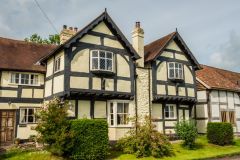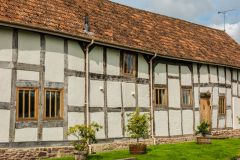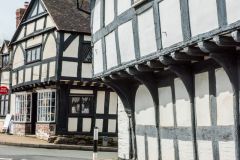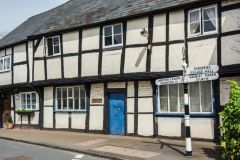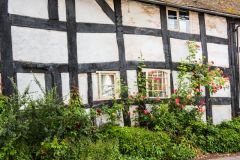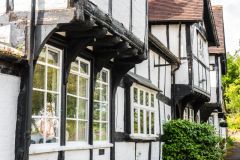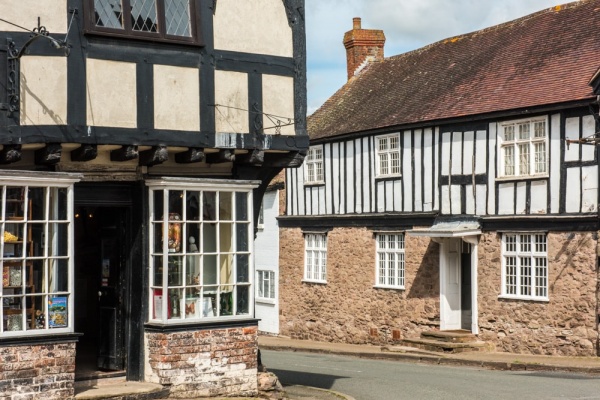
The pretty village of Weobley (pronounced 'Webbly') is one of Herefordshire's famed 'Black and White' villages, famed for their attractive timber-framed buildings. The Daily Mail included Weobley in its list of the 20 most idyllic villages in Britain, and when you explore the village and its wealth of historic buildings it is hard not to agree.
History
The village name comes from the Saxon words 'Wibba' and 'ley'. Wibba was a proper name and ley means a clearing or glade in a woods, so Weobley means 'Wibba's woodland clearing'.
The Domesday Book spelled the name 'Wibelai' and recorded that Weobley was held by a Saxon nobleman named Eadwig Cild before the Norman Conquest. After the Conquest, it was granted to a Norman named Roger de Lacy. The Domesday Book mentions a priest, evidence that a late-Saxon church stood here at the time.
The settlement gained borough status in 1255 and had the right to hold a weekly market and an annual fair. The fair was held since at least 1231 and was centred around the manor house owned by Walter de Lacy. In 1295 the village sent two MPs to Parliament, but the residents later refused to spend the necessary two shillings for the MP's travel and living expenses.
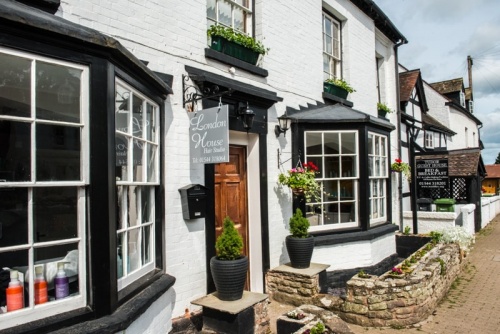
A Rotten Borough
Many years later Weobley was one of the so-called 'rotten boroughs', returning 2 MPs at every election. The selection of MPs was controlled by the local landowners. The legal niceties required that voters must eat and sleep in a place in order to vote, so the landowners would bring in tenants from outside the borough to occupy the village at election time. Once they had voted the tenants returned to their actual abode outside the village. These temporary residents were dubbed 'potwallopers'.
What is a timber-framing?
Timber-framing is a method of construction that began as early as the Stone sage. It involves creating a frame of timber posts and beams, usually freshly cut.
Once the frame has been assembled the space between the timbers is filled in with other material such as stone rubble, cob, or wattle and daub, often painted with a white limewash for protection. The timber posts and beams turn black with age and contrast with the white infill to create the picturesque 'black and white' buildings that make this area of Herefordshire so enjoyable to visit.
The timber-framed buildings in Weobley were built with freshly cut oak. Each beam was cut to size where it was felled. Each timber was numbered so that the building could be easily assembled on-site like a gigantic jigsaw puzzle.
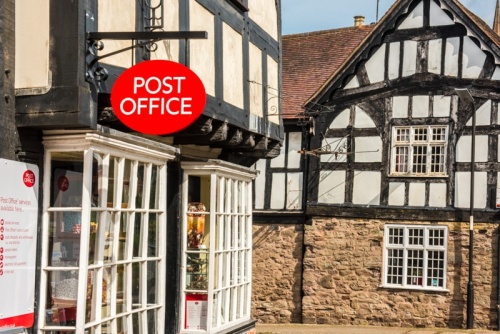
During the medieval period Weobley grew prosperous due to the burgeoning wool trade. The local wool was so profitable it became known as Leominster Ore. Other major industries included glove making, brewing, and nail manufacture.
The village lapsed into economic decline during the 19th century, but this relative poverty meant that its historic timber-framed buildings were not remodelled in the fashion of the day, leaving Weobley with its rich architectural heritage today.
Famous People
One of the most famous residents of Weobley was Colonel John Birch, a prominent Civil War soldier who fought for Parliament. Birch commanded the Parliamentary soldiers who captured Hereford by trickery, dressing as ice-breakers to cross the frozen River Wye. Birch was rewarded by being named Governor of the city. He helped rebuild the striking spire of St Peter & St Paul's Church after it collapsed, and his striking memorial is inside the church.
Another notable resident, though for completely different reasons, was James Tomkins, a 16th-century resident who lived where the Rose Garden now stands n the centre of the village. Tomkins fathered 33 children by two wives and is remembered in the verse:
Babes thirty three did from two mothers spring,
To famous Tomkins, O, admired thing!
And may the loud resounding trump of fame,
Proclaime great Tomkins for a man of men.
No verse commemorates his wives!
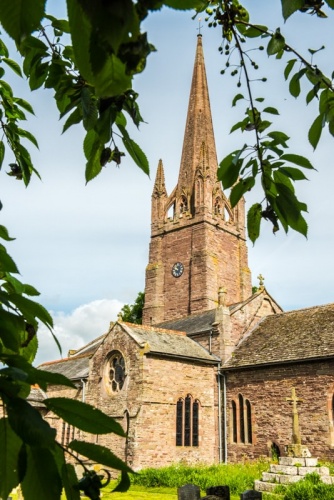
Another famous resident of Weobley was Ella Mary Leather, author of the 1912 book 'The Folklore of Herefordshire'. Leather also collected folk songs from Weobley residents, recording words and music. On one occasion she was accompanied by the composer Ralph Vaughan Williams, who was so inspired by a gypsy melody that he incorporated the song into his 'Fantasia on Christmas Carols'.
Weobley Museum
You can explore the rich history of Weobley in this delightful small museum beside the library. The museum looks in-depth at life in the region over the past 200 years, with paintings of local; scenes, old photos, parish records, agricultural tools, and objects made by local craftsmen. Models show how Weobley's picturesque timber-framed buildings were constructed.
St Peter & St Paul Church
A short stroll from the busy Broad Street leads to Weobley's 13th-century parish church. This large church with its striking spire is the third on the same site. The earliest was a timber church built in the late Saxon period. The unusual spire - the second-highest in Herefordshire - is built with a unique set of four flying buttresses linked to pinnacles at each corner of the tower.
Within the church, you will find three 15th-century effigies including that of Sir William Devereux who died in 1402 during Owain Glyndwr's Rebellion. Another monument of note is a gilded statue commemorating Colonel John Birch.
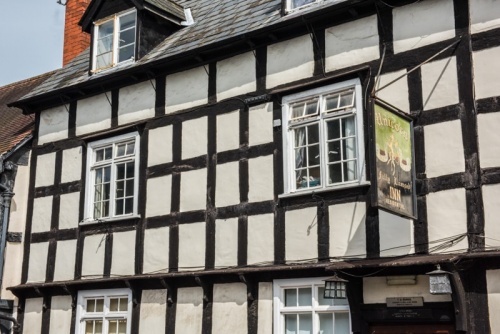
Weobley Castle
At the south end of Broad Street a footpath leads to the intriguing remains of an early medieval earthwork. The castle at Weobley was first recorded during the Anarchy, that period in the middle of the 12th century when King Stephen and Empress Matilda fought for the crown. Many unlicensed castles were thrown up during this tumultuous period and Weobley was probably one of these 'adulterine' castles.
Historical records show that King Stephen captured the castle in 1140, and by 1210 it was owned by the powerful Norman lord, William de Braose. No trace of masonry survives, though a 17th-century drawing shows a stone keep that appears to be in 13th-century style.
Visiting
There is parking on Broad Street but it can fill up. There is a free car park at the junction of the B4230 and Bell Square. From there it is a very short stroll to the west end of Broad Street.
Weobley is a delight to explore. There is a very good Heritage Trail linking historic buildings around the village centre, with information panels at each major point.
The Heritage Trail includes the house where Charles I stayed during the Civil War, at the corner of High Street and Hereford Street. In Charles' time it was a coaching inn named The Unicorn, but after his visit it was renamed The Throne. It is now a private dwelling.
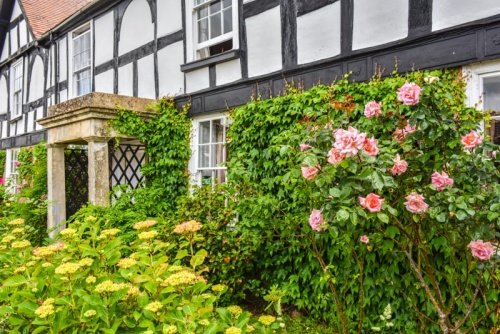
There is still a Unicorn pub; it stands opposite The Throne and dates to the 17th century. The Unicorn had its own orchard for growing cider apples. The workers who picked the apples were paid in tokens that could only be redeemed in the pub.
The Heritage Trail also highlights a row of four medieval shops on Broad Street. Tree-ring dating techniques have determined that the shops date to the period 1461-1479. At the bottom of Broad Street is Old Corner House, also dating to the 15th century.
Further away from the village centre you will find The Ley, a 16th-century manor house, and the old grammar school, built in 1660.
The estate agency Savills recently named Weobley as the 8th most desirable village in Britain, and when you visit it is easy to see why. Weobley deserves its reputation as one of the most beautiful and inviting Black and White Villages in Herefordshire.
About Weobley
Address: B4230,
Weobley,
Herefordshire,
England
Attraction Type: Village
Location: On the B4230 roughly 12 miles north-west of Hereford. Village parking area at the junction of the B4230 and Bell Square.
Website: Weobley
Location map
OS: SO402515
Photo Credit: David Ross and Britain Express
HERITAGE
 We've 'tagged' this attraction information to help you find related historic attractions and learn more about major time periods mentioned.
We've 'tagged' this attraction information to help you find related historic attractions and learn more about major time periods mentioned.
Find other attractions tagged with:
NEARBY HISTORIC ATTRACTIONS
Heritage Rated from 1- 5 (low to exceptional) on historic interest
Weobley Museum - 0.1 miles (Museum) ![]()
Weobley, St Peter & St Paul - 0.2 miles (Historic Church) ![]()
Dilwyn, St Mary Church - 2.1 miles (Historic Church) ![]()
Wormsley, St Mary Church - 2.8 miles (Historic Church) ![]()
Yazor, St Mary the Virgin Church - 3.1 miles (Historic Church) ![]()
Stretford, St Cosmos & St Damian Church - 3.7 miles (Historic Church) ![]()
Kinnersley Castle - 3.7 miles (Castle) ![]()
Westonbury Mill Water Gardens - 3.7 miles (Garden) ![]()
